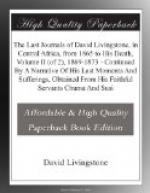The broad waters of the long-looked for Luapula soon hove in sight. Putting themselves under a guide, they were conducted to the village of Chisalamalama, who willingly offered them canoes for the passage across the next day.[37]
As one listens to the report that the men give of this mighty river, he instinctively bends his eyes on a dark burden laid in the canoe! How ardently would he have scanned it whose body thus passes across these waters, and whose spirit, in its last hours’ sojourn in this world, wandered in thought and imagination to its stream!
It would seem that the Luapula at this point is double the width of the Zambesi at Shupanga. This gives a breadth of fully four miles. A man could not be seen on the opposite bank: trees looked small: a gun could be heard, but no shouting would ever reach a person across the river—such is the description given by men who were well able to compare the Luapula with the Zambesi. Taking to the canoes, they were able to use the “m’phondo,” or punting pole, for a distance through reeds, then came clear deep water for some four hundred yards, again a broad reedy expanse, followed by another deep part, succeeded in turn by another current not so broad as those previously paddled across, and then, as on the starting side, gradually shoaling water, abounding in reeds. Two islands lay just above the crossing-place. Using pole and paddle alternately, the passage took them fully two hours across this enormous torrent, which carries off the waters of Bangweolo towards the north.
A sad mishap befell the donkey the first night of camping beyond the Luapula, and this faithful and sorely-tried servant was doomed to end his career at this spot!
According to custom, a special stable was built for him close to the men. In the middle of the night a great disturbance, coupled with the shouting of Amoda, aroused the camp. The men rushed out and found the stable broken down and the donkey gone. Snatching, some logs, they set fire to the grass, as it was pitch dark, and by the light saw a lion close to the body of the poor animal, which was quite dead. Those who had caught up their guns on the first alarm fired a volley, and the lion made off. It was evident that the donkey had been seized by the nose, and instantly killed. At daylight the spoor showed that the guns had taken effect. The lion’s blood lay in a broad track (for he was apparently injured in the back, and could only drag himself along); but the footprints of a second lion were too plain to make it advisable to track him far in the thick cover he had reached, and so the search was abandoned. The body of the donkey was left behind, but two canoes remained near the village, and it is most probable that it went to make a feast at Chisalamalama’s.
[Illustration: An old Servant destroyed.]
Travelling through incessant swamp and water, they were fain to make their next stopping-place in a spot where an enormous ant-hill spread itself out,—a small island in the waters. A fire was lit, and by employing hoes, most of them dug something like a form to sleep in on the hard earth.




